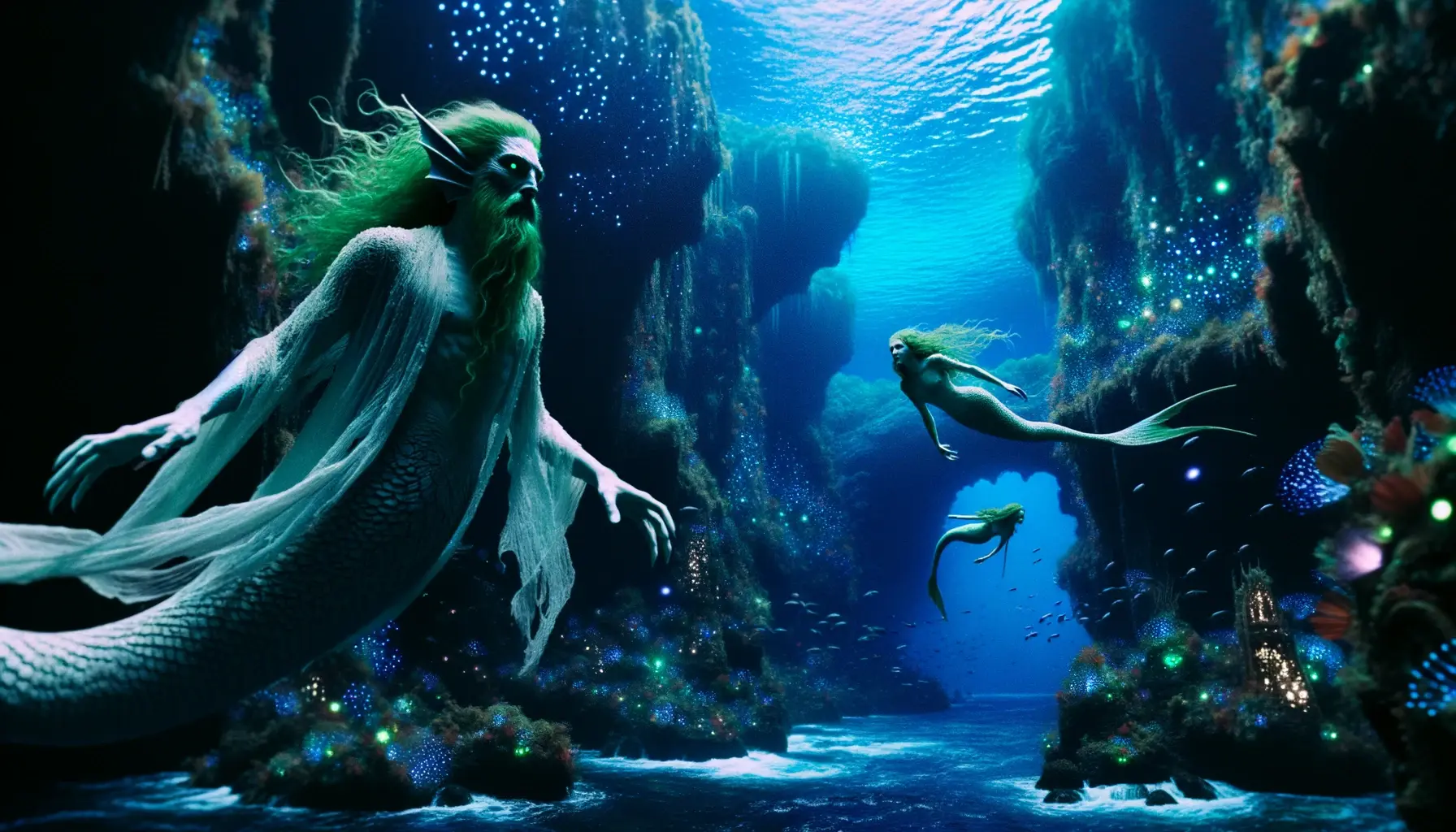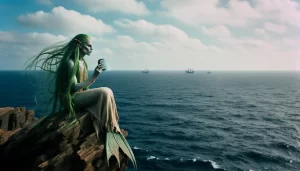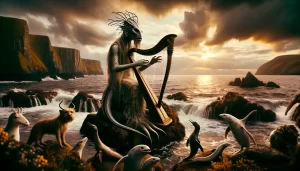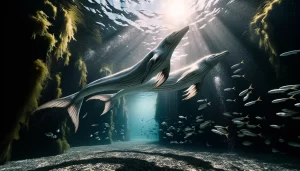Origins and Legends
Merrow mythology refers to the mythical creatures that have been a part of Irish folklore for centuries. In Irish mythology, these mystical sea creatures are often depicted as beings of great beauty, grace, and allure, with long flowing hair and shimmering scales. The origins of the merrow are believed to be rooted in the ancient Celtic mythology, which was heavily influenced by the sea and the natural world.
According to legend, the merrow is a mermaid or merman who requires a magical cap, known as the cohuleen druith, to travel between deep water and dry land. The term merrow is believed to come from the Irish words muir (sea) and oigh (maid), which makes their name identical to the Greek mermaids. The Scottish word for the same creature is morrough. Some scholars also translate the name as sea singer or sea monster, but fewer people ascribe to these hypotheses.
In Irish folklore, merrows were often seen as protective spirits of the sea, who would guide sailors to safety or warn them of impending danger. They were also known to be skilled musicians and storytellers, often luring humans into the sea with their enchanting songs and tales. The Annals of the Kingdom of Ireland, a chronicle of Irish history, mentions merrows as early as the 6th century, suggesting that they have been a part of Irish culture for a very long time.
The Fomorians, a race of supernatural beings in Irish mythology, were said to be the enemies of the merrows, often depicted as fierce sea monsters who would battle the merrows for control of the sea. Despite this conflict, merrows were still seen as benevolent beings who were respected and revered by the people of Ireland. Today, merrows continue to be a popular subject in Irish storytelling and mythology, inspiring many works of art and literature.
Physical Appearance and Characteristics
Merrow-Women
Merrow-women are often described as beautiful and alluring, with a human-like upper body and a fish-like lower body covered in greenish-tinted scales. They have long, flowing green hair which they are often seen grooming with a comb. Their hands have thin webbing between the fingers, and their feet are flatter than those of humans. Merrow-women are known for their enchanting singing voices that can lure sailors to their deaths.
Merrow-Men
Merrow-men, on the other hand, are often described as hideous and ugly. They have scaly skin, pointed teeth, and a fish-like lower body covered in scales. They are known to be aggressive and hostile towards humans, often dragging them to the depths of the ocean. Merrow-men are known for their strength and agility, making them formidable opponents.
Magical Abilities and Artifacts
Merrows are known for their magical abilities and possession of enchanted artifacts. These abilities and artifacts allow them to live and thrive both on land and in the sea.
Cohuleen Druith
One of the most well-known artifacts of the merrows is the Cohuleen Druith, also known as the magical cap. This cap enables the merrow to dive deep into the ocean and transform from their human form to their sea-dwelling form. It is said that the cap holds the merrow’s enchantment and ensures they can return to the sea whenever they wish.
Sealskin Cloaks
Another artifact of the merrows is the sealskin cloak. This cloak allows the merrow to transform into a seal and move freely through the water. It is said that if a man were to take away a merrow’s sealskin cloak, he could force her to stay on land with him, incapable of returning to the sea.
The Soul Cages
The merrows also possess the ability to enchant humans with their singing and lure them into the sea. These humans are then kept in the merrow’s Soul Cages, which are said to be made of silver and gold. The merrows keep these humans in an enchanted state, where they are unable to leave the cage or even desire to leave.
Interactions with Humans
Merrows are known for their interactions with humans, which have been documented in many Irish folklore tales. These interactions can range from encounters at sea to marriages and relationships.
Encounters at Sea
Merrows are often encountered by sailors and fishermen at sea. According to legend, merrows have the power to control the sea and can create storms or calm waters at will. They are also said to be able to shapeshift into various sea creatures, such as seals or dolphins. These encounters are usually peaceful, and merrows are known for their gentle and affectionate nature towards humans.
Marriages and Relationships
Merrows have been known to form relationships with humans and even marry them. In some cases, merrows have been said to take human husbands or lovers and live with them on land. However, these relationships are not without consequences. If a human were to steal a merrow’s skin, she would be bound to stay with them and unable to return to the sea. This is a common theme in many merrow tales, including the story of the MacNamara bride in County Clare.
The MacNamara bride was a merrow who married a mortal man. However, her husband stole her skin, and she was forced to stay on land with him. The MacNamara family eventually found out and returned her skin, allowing her to return to the sea. This story is often used as a cautionary tale about the dangers of marrying a merrow.
Other Interactions
Merrows have also been known to interact with humans in other ways. In some tales, merrows have helped fishermen by guiding them to the best fishing spots. In other stories, merrows have saved drowning humans or helped lost children find their way home.
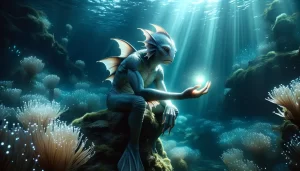
Benevolent and Malevolent Merrows
Merrows, as one of the sidhe races, could be both benevolent and malevolent, depending on the legend. Some legends depict merrows as benevolent creatures, while others portray them as malevolent and vengeful. In Irish folklore, merrows are believed to be capable of attachment to human beings, with reports of intermarriage.
According to legend, a merrow named Suire fell in love with a man named O’Flaherty and married him. They had several children, but Suire always longed to return to the sea. When O’Flaherty found out about her desire, he took her coat, which enabled her to live underwater, and hid it. Suire became ill and eventually died. Her children, who were half-merrow, were said to have webbed fingers and toes and were able to breathe underwater.
In some parts of Ireland, merrows are regarded as messengers of doom and death, similar to the Banshee. They are said to have special clothing that enables them to travel through ocean currents. They are also known to be wary of humans and have a natural antipathy towards them.
Male merrows, in particular, are said to be malevolent and incredibly ugly. There are stories of female merrows seducing human men, singing to them and then dragging them under the waves to the bottom of the sea.
Geographical Distribution
Merrows are mythical creatures that are believed to inhabit the waters off the west coast of Ireland. They are said to be found in the counties of Kerry and Clare, where the Atlantic Ocean meets the rugged coastline. According to local legends, merrows are most commonly found near rocky outcrops and hidden coves, where the water is deep and the currents are strong.
While there is no scientific evidence to support the existence of merrows, their myth has been passed down through generations of Irish folklore. In recent years, there have been reports of people claiming to have seen merrows, but these sightings are often dismissed as hoaxes or misinterpretations of natural phenomena.
Despite the lack of concrete evidence, the myth of the merrow continues to capture the imagination of people around the world. Many believe that the stories of these mythical creatures are rooted in the real-life experiences of Irish fishermen and sailors who have encountered unusual creatures in the waters off the west coast of Ireland.
Frequently Asked Questions
What is the myth of merrows?
Merrows are mythical creatures in Irish folklore that are believed to be mermaids or mermen. According to the myth, they live in the sea and have the ability to travel between the deep water and dry land. They are known for their magical caps, which allow them to travel between the two worlds.
What is the Celtic word for mermaid?
The Celtic word for mermaid is “muirgheilt,” which means “sea servant” or “sea maiden.” It is a combination of the words “muir,” meaning “sea,” and “gheilt,” meaning “servant” or “maiden.”
What is a merrow in Irish?
In Gaelic Irish, a merrow is known as a “morúadh.” The word is a combination of “muir,” meaning “sea,” and “oigh,” meaning “maid.” It specifically refers to the female of the species.
What is the difference between a merrow and a mermaid?
The main difference between a merrow and a mermaid is that merrows are specifically associated with Irish folklore and are believed to have magical caps that allow them to travel between the sea and land. Mermaids, on the other hand, are found in many different cultures and are typically associated with the sea.
What is the meaning of merrow?
The word “merrow” comes from the Irish word “morúadh,” which means “sea maiden.” It specifically refers to the female of the species.
What is the pronunciation of merrow?
The pronunciation of merrow is “MER-oh.”
To learn more about the Merrows, check out this great video on the subject:

